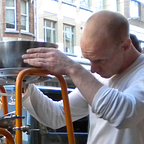The Future of Work in the Collaborative City
In 1923 (I will repeat that: nineteen twenty three!) the Green Bay Packers, an American National Football League team, were on the verge of bankruptcy.
Rather than close their doors, they decided to sell shares to the community, a small working class town where most people worked in the meat packing industry. At $5 a share, they managed to raise the necessary $5,000 from the community to carry on. The company was to be not-for-profit, and a limit was put on the number of shares a single person could hold.
Almost a century on, the team still abides by those same rules, and is still going strong. In 2010 it even won the Super Bowl, by Americans modestly referred to as the World Championship. This despite NFL-regulation being changed in 1960 prohibiting non-profit making teams and teams with more than 30 shareholders from taking part. There are now about 360,000 shareholders, from the wider Midwest, but largely from the 100,000-inhabitant town of Green Bay, making it the only small town team in the NFL.
The shareholders elect a board of directors, but a General Manager makes football decisions.
“Without an impatient, jittery billionaire breathing down his neck, the GM has the space to see his moves succeed or fail on their own accord,” the New Yorker reported in 2010.
Fielding an unproven talent instead of a legendary quarterback in 2008 proved controversial at the time, but 2 years on the younger talent was chosen Most Valuable Player of the competition.
In the 21st century we have a plethora of words describing the political economy of a phenomenon like the Green Bay Packers.
What was just a good idea between the Wars, went out of vogue in the 1960s to the point of being outlawed, and is gaining currency now as crowdsourcing, network economy, platform cooperativism or sharing economy. It inspires taxi drivers in Bologna, childcare collectives in New York and mobile phone providers in London.
Historically, these were predominantly collective efforts to provide a service the market failed to offer. The community saved the Green Packers when investors looked the other way; another case in point is the provision of utilities. Though 90% of urban homes had electricity in the 1930s, in rural areas only 10% of homes were supplied, because companies worried that the investment of connecting them would never pay itself back. So rural communities set up their own utility firms, owned by consumers. Though small in part of the population they reach, these coops in 2006 still provide power to 75% of the US geography.
Now, we increasingly come across more critical and demanding actions in the field of collective ownership.
In September 2016, at the time social networking service Twitter was put up for sale, media studies professor Nathan Schneider wrote an opinion piece in The Guardian entitled “Here is my plan to save Twitter: let’s buy it.” In it, he referred to the Green Bay Packers, and proposed a similar structure for Twitter, but it would be a buy-out rather than a public offering. The article sparked a popular movement, a hash tag #WeAreTwitter, and resulted in a letter written to the board of Twitter.
The greatest merit of the movement, however, was to launch a debate about the democratic ownership of social media and public services for communication. The campaign made it to Twitter’s shareholder meeting, but after that focussed more on influencing the shareholders rather than becoming them. Initiatives like this are not limited to new technologies and social media. In Antwerp, the collective “Let’s buy Oudaan”, supported by architects practice NDVR attempted a collective purchase of an iconic high rise office block, also to generate debate about its value as a collective good rather than to shift ownership (see also brochure Open Promotor Platform in this series).
American philosopher John Dewey wrote in the 1940s:
“All those who are affected by social institutions must have a share in producing them and managing them.”
He explained that because you become what you are by the institutions under which you live, in a democracy you should have a say in shaping them. It is the type of thinking that now inspires economic practices that put community and user benefit before profit.
It criticises what is referred to as the sharing economy, practices like Uber and AirBnB, because these use the peer-to-peer ethos but still from a profit and return-on-investment perspective.
Platform cooperativism, network economy and other collective efforts cannot hide the fact that in policy terms the pursuit of economic well-being is still synonym with increasing productivity.
It is argued in the first brochure of this series (Economy and Skills) that the limits to growth confront us with a stark choice: do more with less, or make do with less; increase technologic advancement so that we can produce the necessary goods with the available limited resources, or change our lifestyles and adapt consumption patterns to a level that would be sustainable for a global population. Denying the populations of former developing countries the lifestyles we have would be unacceptable; hence those from earlier industrialised countries will have to adjust their consumption patterns.
Increasing productivity, it was promised in the past (see also brochure Elephant Path in this series), would mean we that we would have to work less to earn our living.
In 2017, people work longer for less money. The reason being that the benefits of increased productivity are not harvested by those who work, but by those who invest and own the companies.
In other words, the fault is in the ownership of the institutions that employ workers.
